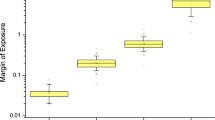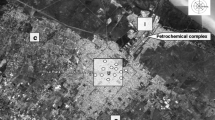Summary
In order to assess the uptake of benzene from environmental tobacco smoke (ETS) and to estimate its contribution to the total body burden of benzene observed in non-smokers, two experimental studies have been conducted. Controlled exposure to high levels of ETS equivalent to 10 ppm CO for 9 h and 20 ppm for 8 h resulted in a nonsignificant increase in blood benzene levels and a significant increase in exhaled CO, COHb and cotinine in serum and urine. The slightly rising blood concentration of benzene following experimental ETS exposure was paralleled by an increased exhalation of benzene and aromatic hydrocarbons and in contrast to blood levels, this increase was significant. The blood levels of benzene obtained during exposure were comparable to those observed at the time of admission to the laboratory, when biomarkers of ETS uptake, e. g. cotinine in serum and urine, were at the limit of detection, thus demonstrating that these background levels were not from ETS exposure. No difference in the urinary excretion of phenol, the main metabolite of benzene, was found during the experimental periods. The background levels of urinary phenol in unexposed nonsmokers were rather high, demonstrating that phenol excreted in urine must be formed from several endogenous and exogenous precursors. In the ligth of our findings it is highly questionable whether exposure to benzene from ETS under real life conditions poses a cancerogenic risk to the general population, which is measurable today or in the future by toxicological or epidemiological methods.
Similar content being viewed by others
Abbreviations
- ETS:
-
environmental tobacco smoke
- BTX:
-
benzene/ethylbenzene/toluene/m- andp-xylene/o-xylene
References
Ames BN (1990) Mutagenesis and carcinogenesis: exogenous and endogenous factors. Symposium 13: endogenous versus exogenous factors as major cancer risk determinants. Am Assoc Cancer Res 31:512
Angerer J, Scherer, G, Schaller KH, Müller J (1990) The determination of benzene in human blood as an indicator of environmental exposure to volatile aromatic compounds. Fresenius Journal of Analytical Chemistry (in press)
Aringer L, Lidums V (1988) The influence of diet and other factors on urinary levels of thioethers. Int Arch Occup Environ Health 61:123–130
Austin H, Delzell E, Cole P (1988) Benzene and leukemia. A review of the literature and a risk assessment. Am J Epidemiol 127:419–439
Becher H, Jahn I, Jöckel KH, Bödeker W (1987) Passivrauchen als Gesundheitsrisiko (Ministerium für Arbeit, Gesundheit und Soziales des Landes NRW). Busse Druck, Herford
BUA-Stoffbericht 24. Benzol (1988) Hrsg.: Bayer E, Vorsitzender des Beratergremiums für Umweltrelevante Altstoffe (BUA) der Gesellschaft Deutscher Chemiker 24. VCH, Weinheim, pp 64–66
Eudy LW, Thomas FA, Heavner DL, Green CR, Ingebrethsen BJ (1986) Studies on the vapor-particulate phase distribution of environmental nicotine by selective trapping and detection methods. Proceedings of the Air Pollution Control Association 79th annual meeting, pp 2–14
Fishbein L (1988) Benzene: uses, occurrence and exposure. In: Fishbein L, O'Neill IK (eds) Environmental carcinogens. Methods of analysis and exposure measurement: vol 10. Benzene and alkylated benzenes. IARC Scientific Publications no. 85. IARC, Lyon, pp 67–96
Gesundheitsschädliche Arbeitsstoffe. Toxikologisch-arbeitsmedizinische Begründung von MAK-Werten. In: Henschler D (ed) Benzol. VCH, Weinheim, 1989, pp 1–53
Goldstein BD (1985) Risk assessment and risk management of benzene by the environmental protection agency. In: Hoel DG, Merrill RA, Perera FP (eds) Risk quantitation and regulatory policy. Banbury Report, Cold Spring Harbor Laboratory
Grimmer G, Naujack KW, Dettbarn G (1987) Gaschromatographic determination of polycyclic aromatic hydrocarbons, azaarenes, aromatic amines in sidestream smoke of cigarettes. Toxicol Lett 35:117–124
Haley NJ, Sepkovic DW, Brunnemann KD, Hoffmann D (1989) Biomarkers for assessing environmental tobacco smoke uptake. In: Harper JP (ed) Combustion process and the quality of the indoor environment. Air and Waste Management Association, Pittsburgh, pp 201–213
Heinonen T, Kytöniemi V, Sorsa M, Vainio H (1983) Urinary excretion of thioethers among low-tar and medium-tar cigarette smokers. Int Arch Occup Environ Health 52:11–16
Hengen N, Hengen M (1978) Gas-liqiud chromatographic determination of nicotine and cotinine in plasma. Clin Chem 24:50–53
Hiller FC, McCusker KT, Mazumder MK, Wilson JD, Bone RC (1982) Deposition of sidestream cigarette smoke in human respiratory tract. Am Rev Respir Dis 125:406–408
Hinds W, First MW, Huber GL, Shea JW (1983) A method for measuring respiratory deposition of cigarette smoke during smoking. Am Int Hyg Assoc J 44:113–118
Hoffmann D, Brunnemann KD, Hoffmann I (1989) Significance of benzene in tobacco carcinogenesis. Adv Mod Environ Toxicol 16:99–130
Huff JE, Haseman JK, DeMarini DM, Eustis S, Maronpot RR, Peters AC, Persing RL, Chrisp CE, Jacobs AC (1989) Multiplesite carcinogenicity of benzene in Fischer 344 rats and B6C3F1, mice. Environ Health Perspect 82:125–163
International Agency for Research on Cancer (1986) Tobacco smoking. IARC Monographs on the evaluation of the carcinogenic risk of chemicals to humans: vol 38. IARC, Lyon
International Agency for Research on Cancer (1988) Fishbein L, O'Neill IK (eds) Environmental carcinogens. Methods of analysis and exposure measurement: vol. 10. Benzene and alkylated benzenes. IARC Scientific Publications no. 85. IARC, Lyon
Kiefer JE (1978) Ventilated filters and their effect on smoke composition. Recent Adv Tobacco Sci 4:69–111
Klus H, Begutter H, Ball M, Intorp M (1987) Environmental tobacco smoke in real life situations. In: Seifert et al. (eds) Indoor Air '87. Proceedings of the 4th International Conference on Indoor Air Quality and Climate: vol 1. Volatile organic compounds, combustion gases, particles and fibres, microbiological agents. Institute for Water, Soil and Air Hygiene, Berlin
Krause C, Mailahn W, Nagel R, Schulz C, Seifert B, Ullrich D (1987) Occurrence of volatile organic compounds in the air of 500 homes in the Federal Republic of Germany. In: Seifert et al. (eds) Indoor Air '87. Proceedings of the 4th International Conference on Indoor Air Quality and Climate: vol 1. Volatile organic compounds, combustion gases, particles and fibres, microbiological agents. Institute for Water, Soil and Air Hygiene, Berlin
Kuwata K, Uebori M, Yamasaki H, Kuge Y (1983) Determination of aliphatic aldehydes in air by liquid chromatography. Anal Chem 55:2013–2016
Langone JJ, Gjika HB, Van Vunakis H (1973) Nicotine and its metabolites: radioimmunoassay for nicotine and cotinine. Biochemistry 12:5025–5030
Maltoni C, Conti B, Cotti G, Belpoggi F (1985) Experimental studies on benzene carcinogenicity at the Bologna Institute of Oncology: current results and ongoing research. Am J Indust Med 7:415–446
Martin F, Hoepfner I, Scherer G, Adlkofer F, Dettbarn G, Grimmer G (1989) Urinary excretion of hydroxy-phenanthrenes after intake of polycyclic aromatic hydrocarbons. Environ Int 15:41–47
NIOSH Manual of Analytical Methods, Method 1500/1501 (1984) US Department of Health and Human Services, vol 1, pp 84–100
Norpoth K (1989) Benzol. In: Henschler D, Lehnert G (eds) Biologische Arbeitsstoff-Toleranz-Werte (BAT-Werte). B 1, 1–18
Ogden MW (1989) Gas Chromatographic determination of nicotine in environmental tobacco smoke: collaborative study. J Assoc Off Anal Chem 72:1002–1006
Oldaker III GB, Perfetti PF, Conrad FC Jr, Conner JM (1990) Results from surveys of environmental tobacco smoke in offices and restaurants. In: Kasuga (ed) Indoor air quality. Springer, Berlin Heidelberg New York, pp 99–104
Pellizzari ED, Zweidinger RA, Sheldon LS (1988) Breath sampling. In: Fishbein L, O'Neill IK (eds) Environmental carcinogens. Methods of analysis and exposure measurement: vol 10. Benzene and alkylated benzenes. IARC Scientific Publications no. 85, IARC, Lyon, pp 255–266
Proctor CJ, Warren ND, Bevan MAJ (1989) Measurements of environmental tobacco smoke in an air-conditioned office building. Environ Technol Lett 10:1003–1018
Proctor CJ, Warren ND, Bevan MAJ, Baker-Rogers J (1990a) A comparison of methods of assessing exposure to environmental tobacco smoke in non-smoking British women. Environ Int (in press)
Proctor CJ, Warren ND, Bevan MAJ, Baker-Rogers J (1990b) Measurements of airborne substances in single-decker buses with and without smoking prohibition. Anal Chem (in press)
Scherer G, Westphal K, Biber A, Hoepfner I, Adlkofer F (1987) Urinary mutagenicity after controlled exposure to environmental tobacco smoke (ETS). Toxicol Lett 35:135–140
Scherer G, Conze C, Meyerinck Lv, Sorsa M, Adlkofer F (1990) Importance of exposure to gaseous and particulate phase components in tobacco smoke in active and passive smokers. Int Arch Occup Environ Health (in press)
Snyder CA (1987) Benzene. In: Snyder R (ed) Ethel Browning's toxicity and metabolism of industrial solvents, 2nd ed: vol 1. Hydrocarbons. Elsevier, Amsterdam
Sterling TD, Dimich H (1982) Indoor byproduct levels of tobacco smoke. A critical review of the literature. J Air Pollut Control Assoc 32:250–259
Surgeon General, A Report of the U. S. Department of Health and Human Services (1986) The health consequences of involuntary smoking. U. S. Government Printing Office, Washington DC
Wallace LA (1989) Major sources of benzene exposure. Environ Health Perspect 82:165–169
World Health Organisation (1987) Air quality guidelines for Europe. WHO Regional Publication, European Series no. 23. World Health Organization, pp 45–58
Author information
Authors and Affiliations
Additional information
Dedicated to Professor Dr. Dietrich Schmähl on the occasion of his 65th birthday
Rights and permissions
About this article
Cite this article
Adlkofer, F., Scherer, G., Conze, C. et al. Significance of exposure to benzene and other toxic compounds through environmental tobacco smoke. J Cancer Res Clin Oncol 116, 591–598 (1990). https://doi.org/10.1007/BF01637079
Received:
Accepted:
Issue Date:
DOI: https://doi.org/10.1007/BF01637079




